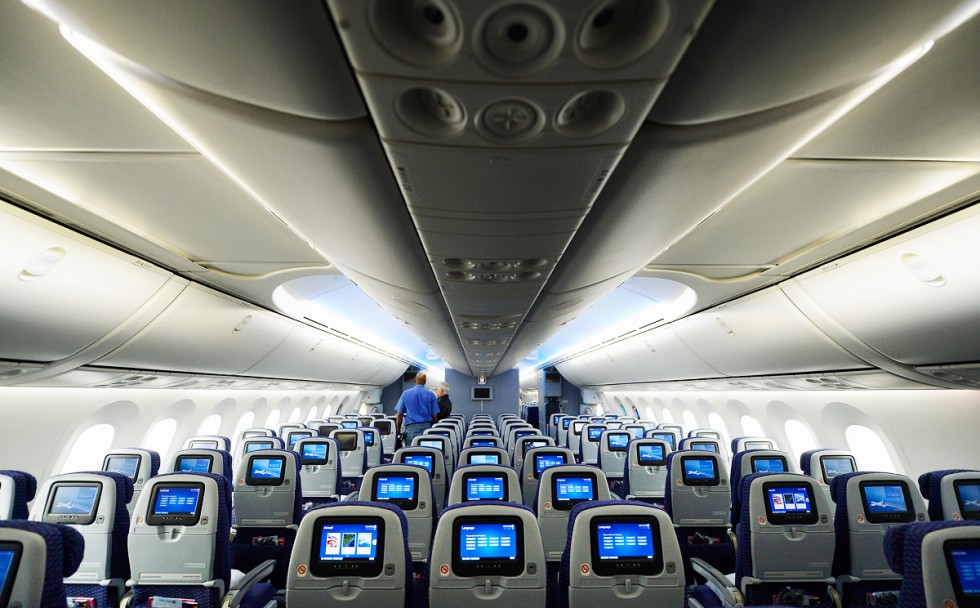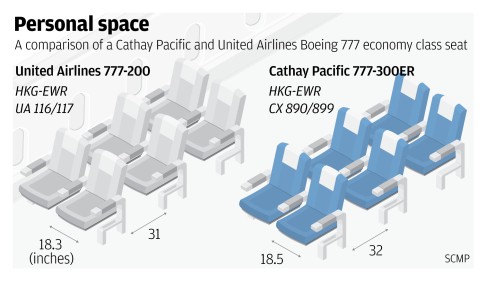Shrinking space on passenger planes 'could damage health and increase air rage'
Efforts to maximise profits by adding more travellers could spark more air rage incidents and inhibit escape routes, report finds
PUBLISHED : Wednesday, 15 April, 2015, 10:55pm
UPDATED : Thursday, 16 April, 2015, 2:58am
Associated Press in Washington

A staff walks through the United Airlines Economy Class with personal entertainment systems on the Boeing 787 Dreamliner at Los Angeles International Airport. Photo: AFP
The shrinking space on planes is surely uncomfortable, but it might also be dangerous for passengers' health and safety.
Planes are filled with more passengers than ever before. Fliers are older and heavier. Flight attendants warn about an increase in air rage, and experts question if having rows of seats packed closer together might make it harder for passengers to evacuate after a crash.
A consumer advisory group set up by the US Department of Transportation (DOT) dived into all those issues on Tuesday at a public hearing as part of its role to make non-binding suggestions to government regulators.
Charlie Leocha, the consumer representative on the committee, said the US government sets standards for the conditions for dogs flying as cargo but doesn't dictate minimum space standards for passengers.
"In a world where animals have more rights to space and food than humans," Leocha said, "it is time that the DOT and FAA [Federal Aviation Administration] take a stand for humane treatment of passengers."

US fliers last summer squeezed into the least amount of personal space in the history of flying. In July, US airlines sold a record 87.8 per cent of seats on domestic flights, according to the Bureau of Transportation Statics. And that figure does not include all the seats occupied by passengers who redeemed frequent flier miles or airline employees flying for free.
"Unfortunately, the days of the empty middle seat are a thing of the past," said Julie Frederick, a representative for the American Airlines flight attendants union.
Following the implementation of checked-bag fees in 2008, Frederick said, more and more passengers are carrying on bags, fighting for overhead bin space. That anger carries over through the flight as passengers bump elbows on armrests and bang their knees against tray tables. There are more cases of air rage, many that go unreported.
Questions were also raised if the increased density means passengers won't be able to evacuate fast enough after a crash.
The FAA runs various tests including how fast passengers can evacuate a plane and how fast they can put on a life preserver.
But Cynthia Corbertt, a FAA researcher, testified that it conducts those tests using planes with 77.5cm between each row of seats. Many passenger jets today have less leg room. For instance, United Airlines has 75cm of room, known as pitch, on some jets; Spirit Airlines offers 70cm.
"We just haven't considered other pitches," Corbertt told the Advisory Committee for Aviation Consumer Protection.
Before any new jet is allowed to fly, the manufacturer must prove that everybody can evacuate in 90 seconds with half of the exits blocked.
Carry-on baggage is strewn throughout the cabin, and the test is conducted in night-like conditions. However, the cabin is not filled with smoke, and all passengers are physically fit, dressed in athletic clothing and know that an evacuation is coming.
"We'd like to see more realistic simulations," Frederick said.
After years of major losses and a wave of bankruptcies, airlines are finally profitable again after adding baggage fees and increasing the number of seats on jets. Last year, US carriers earned more than US$11 billion.
Airlines do offer coach passengers more leg room, if they are willing to pay for it. Many travellers aren't.
Keith Hansen, director of government affairs for budget carrier Allegiant Air, said the thing the majority of holiday makers care most about is price.
"The only way we can offer a low airfare ... is to increase the seating density so we can divide the cost of operating a flight among the greatest number of people possible," Hansen said.
